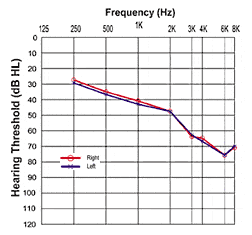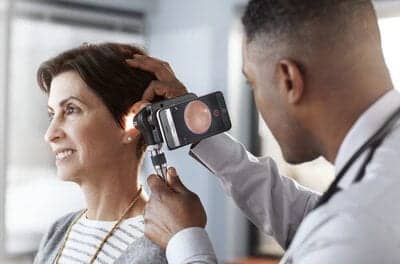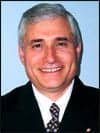A new DSP platform has been developed for use in providing amplification for treatment of hearing loss. This platform uses multi-channel compression with very fast and symmetric attack and release times. New features include programmable directional microphones and the patent-pending DIRECTIONAL-focus™, an adaptive algorithm that adjusts gain in each channel based upon the calculated direction of sound. In this new system, gain is reduced as the signal moves to the sides and rear of the hearing aid user.
In the Sonic Innovations Innova™ hearing aid, the adaptive DIRECTIONALfocus algorithm is combined with conventional directionality to provide directional measures that can surpass traditional directionality.1 With Innova, the performance of older, hearing-impaired adults approaches the ability of younger, normal-hearing adults to understand speech in noise.
Bench-top measures can be used to evaluate and compare this system to previous or competitive platforms, highlighting differences in approach, and the potential of these systems to provide performance improvements in the real world.2 Behavioral measures of performance are the next step in quantifying the benefit from the system. Laboratory measures using the Hearing In Noise Test (HINT)3 were collected, in quiet and in noise, to determine whether previous product performance claims can be carried forward and applied to this new platform.
The HINT measures Reception Thresholds for Sentences (RTS), as distinguished from conventional Speech Reception Thresholds (SRT) measured with word lists. An RTS is measured using an adaptive technique described in general terms by Levitt.4 Sentences are presented in quiet or mixed with noise (using white noise filtered to match the long-term average spectrum of the sentences) presented at a fixed level. The RTS is the level at which the sentences can be repeated correctly 50% of the time.
Method
Subjects. A total of 23 subjects (16 male and seven female) took part in this study. The mean age of the subjects was 63 years old (ranging from ages 30-90). Mean audiometric data are presented in Figure 1. All subjects were native speakers of American English, had one year or more of previous hearing aid experience, and had stable, binaural, symmetrical, sensorineural hearing loss.

Apparatus. Subjects were tested in an environment and with materials in accordance with the HIA Guidelines for Substantiation of Marketing Claims.5 Test signals (sentence lists and speech-shaped noise) were stored on hard disk in digital files on a Yamaha AW4416 digital audio workstation (DAW). A Madsen 922 (version 2) Orbiter audiometer was used to control the level of sentence signals, which were played in the soundfield through RCA PRO-X44AV loudspeakers. Uncorrelated maskers (when present) were played from four loudspeakers, with levels controlled directly by the DAW.6
The subjects were centered in the soundfield and placed 1 m (referenced to the center of the subject’s head) from five loudspeakers that were placed around the listener. The subjects always faced the loudspeaker in the corner, from which the sentences were presented. Testing was performed in a standard, double-walled audiometric test room (3 m [W] x 3 m [L] x 2.44 m [H]).
Devices. Subjects were fit binaurally with the smallest directional devices that would appropriately accommodate their hearing loss. A total of five subjects were evaluated with ITC-D, six subjects with HS-D, four subjects with ITE-D, three subjects with ITEP-D, and five subjects with BTE-D style hearing aids. The devices were Innova hearing aids.
Innova is a DSP hearing aid using 16 independent channels of compression with fast and symmetric attack and release times. The devices use dual omni-directional microphones to allow omni-directional or directional settings. Directional sensitivity can be chosen from among three polar patterns (hypercardioid, supercardioid, or dipole).

The hearing instrument also includes DIRECTIONALfocus, an axis-dependent gain manipulation that increases the directionality of the device by reducing gain independently in each channel whenever the dominant signal comes from the sides or back, with the amount of gain reduction increasing as the off-axis angle estimate increases (ie, the sound moves “out of focus”). Innova also includes Noise Limiting, a combination of Sonic Innovations’ new, adaptive noise reduction and gain-dependent expansion algorithms. This combination adjusts the amount of noise reduction based upon the degree of hearing loss and the estimated signal-to-noise ratio and level of environmental noise, with more reduction applied for higher noise level conditions.
The hearing aid can be configured with up to four memories using the EXPRESSfit fitting system software. The default setting for Program 1 is omni-directional plus Noise Limiting. The default setting for Program 2 is directional plus Noise Limiting and DIRECTIONALfocus. Program 3 defaults are for the telephone, using separate transfer functions for either the electromagnetic coupling (telecoil) or acoustic coupling (microphone).7
Study design and procedure. Speech testing was performed after the hearing aid fittings were fine-tuned and stabilized. Test administration utilized within-subjects, repeated-measures, randomized block design. The order of lists and conditions was counterbalanced across subjects utilizing a Latin square design. Speech materials were always presented at 0° azimuth. Each subject was tested with speech in broad-band noise (BBN) presented at 65 dB(A), with uncorrelated noise sources at 45°, 135°, 225°, and 315° azimuth, presented simultaneously.

Results
Data included RTS scores for the HINT in BBN unaided (“Unaided”), aided-omni-directional with Noise Limiting (Program 1), and aided-directional with Noise Limiting and DIRECTIONALfocus (Program 2).
An ANOVA was run comparing three repeated measures (Unaided, Program 1, and Program 2). A significant main effect was found [F(2,66)=18.75, p<.001]. Post-hoc comparisons using a Bonferroni correction found significant differences between Unaided and Program 1 and Program 2 wherein the three conditions were all different from each other. A separate t-test comparing Program 2 (directional plus Noise Limiting and DIRECTIONALfocus) to the performance of normal hearing, young adult subjects (data reported in Nilsson et al.6) found no significant difference (p=.12). The results of this analysis are shown in Figure 2.
Discussion
In this initial behavioral evaluation of Innova hearing instruments, significant benefit in noise compared to unaided performance was found for both Program 1 (omni-directional plus Noise Limiting) and Program 2 (directional plus Noise Limiting and DIRECTIONALfocus). In addition, the aided results for older adults (mean age=63 years) using Program 2 were not significantly different from the performance of normal-hearing listeners (mean age=28 years) tested with the same materials in the same acoustic environment. w
Acknowledgments
The authors wish to thank Roxanne Olsen for assistance in subject recruitment and testing, and Rebecca Nilsson for assistance in data entry and analysis.
| This article was submitted to HR by Victor Bray, PhD, Robert Ghent, MS, Michael Nilsson, PhD, and Patrick Murphy, MA, all of whom are researchers at the Auditory Research Department of Sonic Innovations, Inc, Salt Lake City. Correspondence can be addressed to HR or Victor Bray, PhD, Sonic Innovations, Inc, 2795 East Cottonwood Pkwy, Ste 100, Salt Lake City, UT 84121-7036; e-mail: [email protected]. |
References
1. Bray V. New digital hearing aid designed for enhanced directionality. The Hearing Review. 2005;12(1),44-47.
2. Bray V, Nilsson M. A new definition for modern hearing aids [AudiologyOnline Web site]. April 11, 2005. Available at: www.audiologyonline.com/articles/arc_disp.asp?id=1358.Accessed: August 20, 2005.
3. Nilsson M, Soli S, Sullivan J. Development of a hearing in noise test for the measurement of speech reception threshold. J Acoust Soc Am. 1994;95:1085-1099.
4. Levitt H. Adaptive testing in audiology. Scand. Audiol. 1978;6[Suppl]:241-291.
5. Hearing Industries Association. Guidelines for Hearing Aid Manufacturers for Substantiation of Performance Claims. Alexandria, VA: HIA;2003.
6. Nilsson M, Ghent R, Bray V, Harris R. Development of a test environment to evaluate performance of modern hearing aid features. J Am Acad Audiol. 2005;16,27-41.
7. Murphy P, Bray V, Nilsson M, McDowell C. Programming algorithms for optimal telecoil settings. Poster presented at: 12th Annual Convention of the American Academy of Audiology; Chicago, IL; 2000.




